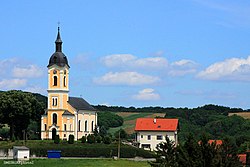Top Qs
Timeline
Chat
Perspective
Bjelovar-Bilogora County
County in central Croatia From Wikipedia, the free encyclopedia
Remove ads
Bjelovar-Bilogora County (pronounced [bjêloʋaːr-bîloɡora]; Croatian: Bjelovarsko-bilogorska županija [bjêloʋaːrsko-bîloɡorskaː ʒupǎnija]) is a county in central Croatia.
The central city of Bjelovar was first mentioned in 1413, and it only gained importance when a new fort was built in 1756 to defend against the Ottoman invasions. The town was pronounced a free royal town in 1874.
The other part of the county name is for the hill of Bilogora that stretches along the northern edge of the county.
Other towns in the county are Daruvar, Garešnica, Čazma, and Grubišno Polje.
The Bjelovar-Bilogora County borders on the Koprivnica-Križevci County in the north, Virovitica-Podravina County in the northeast, Požega-Slavonia County in the southeast, Sisak-Moslavina County in the southwest, and Zagreb County in the west.
Alongside the City of Zagreb and Požega-Slavonia County, it is the only Croatian county that does not border another nation.
Remove ads
Administrative division
Bjelovar-Bilogora County is further divided into 5 towns (grad, pl. gradovi) and 18 municipalities (općina, pl. općine).
Remove ads
Demographics
Summarize
Perspective

As of the 2021 census, the county had 101,879 residents. The population density was 39 people per km2.[2]
As of the 2011 census, the county had 119,764 residents. The population density was 45 people per km2.[5]
Bjelovar-Bilogora County: Population trends 1857–2021
| population | 84893 | 95981 | 101420 | 130901 | 150825 | 163039 | 162453 | 173597 | 166485 | 170651 | 167599 | 157811 | 149551 | 144042 | 133084 | 119764 | 101879 |
| 1857 | 1869 | 1880 | 1890 | 1900 | 1910 | 1921 | 1931 | 1948 | 1953 | 1961 | 1971 | 1981 | 1991 | 2001 | 2011 | 2021 |
Ethnic Croats form the majority with 84.8% of the population, followed by Serbs at 6.3% and Czechs at 5.2%.[6]
Remove ads
Politics
Minority councils and representatives
Directly elected minority councils and representatives are tasked with consulting tasks for the local or regional authorities in which they are advocating for minority rights and interests, integration into public life and participation in the management of local affairs.[7] At the 2023 Croatian national minorities councils and representatives elections Czechs, Hungarians and Serbs of Croatia all fulfilled legal requirements to each elect their own 25 members minority council of the Bjelovar-Bilogora County while Albanians, Germans, and Romani people in Croatia were electing individual representatives.[8] Some municipalities, towns or cities in the county elected their own local minority councils as well.[8]
Although though the Government of the Republic of Croatia does not guarantee official bilinguialism, the statute of Bjelovar-Bilogora County itself guarantees it for the minority languages Albanian, Czech, Hungarian and Serbian.[9]: 3
Protected areas
See also
References
External links
Wikiwand - on
Seamless Wikipedia browsing. On steroids.
Remove ads












